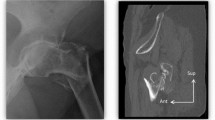Abstract
Background
Predicting rotation of proximal femur in femur fracture surgeries is important to prevent malrotation.
Objective
We aimed to prevent malrotation by developing a simple guideline that enables the prediction of proximal femur rotation using translucent 3-dimensional computed tomography (3D CT).
Design
Retrospective.
Setting
One tertiary general hospital in the Republic of Korea.
Patients
Thirty-six subjects who underwent CT angiographies for vascular evaluation.
Intervention
Translucent 3D CT images were created from the CT data.
Main outcome measure
Morphologic ratios of the great trochanter (GT) and lesser trochanter (LT) with the hip center as a basic point were measured at neutral position and at 5°, 10°, 15°, 20°, 25°, and 30° of internal rotation (IR) and external rotation (ER). The rotation angles at which the GT ratio becomes 0.5 and 0.33 and the rotation angles at which the LT ratio becomes 0.0 and 1.0 were determined to serve as guide angles.
Results
Both the proportion of GT and LT compared with proximal femur with hip center as a reference (GT and LT ratio) gradually increased in the shift from IR to ER. At a neutral position, the GT and LT ratios were approximately 0.4 and 0.5, respectively. At 10°–15° of ER, the approximate GT and LT ratios were 0.5 and 1.0, respectively. At 30° of ER, the GT ratio exceeded 0.6, and the LT ratio exceeded 1.0. Between 10° and 15° of IR, the GT ratio decreased to approximately 0.33 and the LT ratio decreased to 0.0, which indicated that the LT was invisible.
Conclusions
We suggested practical values which might be useful as a reference in the operating room practically and hope that our findings would be helpful to prevent malrotation while performing proximal femur or femur shaft surgeries.




Similar content being viewed by others
References
Braten M, Terjesen T, Rossvoll I (1993) Torsional deformity after intramedullary nailing of femoral shaft fractures. Measurement of anteversion angles in 110 patients. J Bone Joint Surg Br 75(5):799–803
Deshmukh RG, Lou KK, Neo CB, Yew KS, Rozman I, George J (1998) A technique to obtain correct rotational alignment during closed locked intramedullary nailing of the femur. Injury 29(3):207–210
Jaarsma RL, Pakvis DF, Verdonschot N, Biert J, van Kampen A (2004) Rotational malalignment after intramedullary nailing of femoral fractures. J Orthop Trauma 18(7):403–409
Jaarsma RL, Verdonschot N, van der Venne R, van Kampen A (2005) Avoiding rotational malalignment after fractures of the femur by using the profile of the lesser trochanter: an in vitro study. Arch Orthop Trauma Surg 125(3):184–187
Kim JJ, Kim E, Kim KY (2001) Predicting the rotationally neutral state of the femur by comparing the shape of the contralateral lesser trochanter. Orthopedics 24(11):1069–1070
Krettek C, Rudolf J, Schandelmaier P, Guy P, Konemann B, Tscherne H (1996) Unreamed intramedullary nailing of femoral shaft fractures: operative technique and early clinical experience with the standard locking option. Injury 27(4):233–254
Sennerich T, Sutter P, Ritter G, Zapf S (1992) Computerized tomography follow-up of the ante-torsion angle after femoral shaft fractures in the adult. Unfallchirurg 95(6):301–305
Shea JE, Vajda EG, Bloebaum RD (2001) Evidence of a hypermineralised calcified fibrocartilage on the human femoral neck and lesser trochanter. J Anat 198(Pt 2):153–162
Tornetta P III, Ritz G, Kantor A (1995) Femoral torsion after interlocked nailing of unstable femoral fractures. J Trauma 38(2):213–219
Winquist RA, Hansen ST Jr, Clawson DK (1984) Closed intramedullary nailing of femoral fractures. A report of five hundred and twenty cases. J Bone Joint Surg Am 66(4):529–539
Wiss DA, Fleming CH, Matta JM, Clark D (1986) Comminuted and rotationally unstable fractures of the femur treated with an interlocking nail. Clin Orthop Relat Res (212):35-47
Zhang Q, Liu H, Chen W, Li X, Song Z, Pan J et al (2009) Radiologic measurement of lesser trochanter and its clinical significance in Chinese. Skeletal Radiol 38(12):1175–1181
Acknowledgment
We thank Keun Young Shin, Dong Suk Suh, and Bo-Hyun Hwang for their help with data collections and Dong-Su Jang and Hee Yeon Lee for graphical support.
Author information
Authors and Affiliations
Corresponding author
Rights and permissions
About this article
Cite this article
Han, C.D., Lee, Y.H., Yang, K.H. et al. Predicting proximal femur rotation by morphological analyses using translucent 3-dimensional computed tomography. Arch Orthop Trauma Surg 132, 1747–1752 (2012). https://doi.org/10.1007/s00402-012-1609-1
Received:
Published:
Issue Date:
DOI: https://doi.org/10.1007/s00402-012-1609-1




